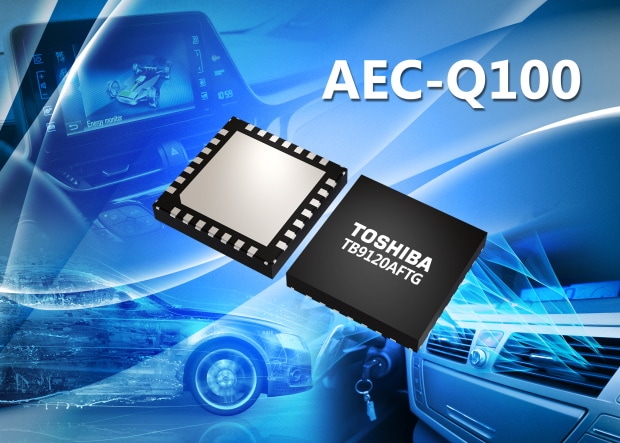July 16, 2020
Featuring mixed decay mode in order to maintain current waveform stability

TOKYO—Toshiba Electronic Devices & Storage Corporation ("Toshiba") has launched the“TB9120AFTG,” a constant-current 2-phase stepping motor driver for automotive applications. The new IC outputs a sine-wave current using only a simple clock input interface, with no need for an advanced functional MCU or dedicated software.
TB9120AFTG was developed as a successor to TB9120FTG, introduced in 2019 as Toshiba’s first automotive stepping motor driver, and provides improved noise resistance. TB9120AFTG incorporates DMOS FETs with low on-resistance (upper + lower = 0.8Ω (typ.)), which achieve a maximum current of 1.5A[1]. Both the DMOS FETs and the controller that generates micro-stepping sine waves (supporting up to 1/32 steps) are housed in a small QFN type package (6.0 mmx6.0 mm).
The new IC delivers an operating temperature range of -40 to 125℃, and meets AEC-Q100, a certified standard for electronic components for automotive applications. It is suited to a wide range of automotive general applications using stepping motors, such as adjustment of the projection position of heads-up displays, and in the expansion valves of refrigerant circuits.
Key features
General multipurpose specifications, especially for automotive applications
- DMOS FETs with low on-resistance (upper + lower = 0.8Ω (typ.)), which achieve a maximum current of 1.5 A.
- Built-in error detections with warning signal output function: Over-current detection, thermal shutdown, and load open.
- Housed in a wettable flank VQFN package (6mm×6mm) with excellent solderability
- Operating temperature range: -40℃ to 125℃
- AEC-Q100 qualified
Micro step drive, supporting up to 1/32 steps.
- Less motor noise, smoother and more precise control
- Uses only a simple clock input interface, with no need for an advanced functional MCU or dedicated software.
- Constant-current PWM control: Mixed decay mode stabilizes current waveforms.
Stall detection function
- A stall detection signal is output from SD pin after detecting a stall.
- The detection signal can be received by a microcontroller and fed back to the system.
Applications
- Mirror adjustment for the projection position of heads-up displays
- Expansion valves in refrigerant circuits for automotive air conditioners and battery management systems
Click below for the product introduction video.
https://videoclip.toshiba.semicon-storage.com/ap-en/detail/videos/products/video/6171426835001/automotive-stepping-motor-driver-ic-tb9120aftg?autoStart=true
For more information about the new product, please visit:
For more information about Toshiba’s automotive stepping motor driver ICs, please visit:
Automotive Stepping Motor Driver ICs
About Toshiba America Electronic Components, Inc.
Toshiba America Electronic Components, Inc. (TAEC), an independent operating company owned by Toshiba America, Inc., is the US based electronic components business of Toshiba Electronic Devices and Storage Corporation. TAEC offers a wide variety of innovative hard disk drive (HDD) products and semiconductor solutions for data center, automotive, industrial, IoT, motion control, telecom, networking, consumer, and white goods applications. The company’s broad portfolio encompasses enterprise and consumer HDDs integrated wireless ICs, power semiconductors, microcontrollers, optical semiconductors.
Note:
[1] Actual driven motor current depends on the use environment, and such factors as ambient temperature and power supply voltage.
*Company names, product names, and service names may be trademarks of their respective companies.
*Information in this document, including product prices and specifications, content of services and contact information, is current on the date of the announcement but is subject to change without prior notice.
Information in this press release, including product pricing and specifications, content of services and contact information, is current and believed to be accurate on the date of the announcement, but is subject to change without prior notice. Technical and application information contained here is subject to the most recent applicable Toshiba product specifications.